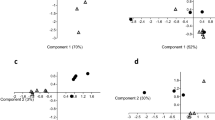Abstract
When provided a choice between grass species with C3 or C4 photosynthetic pathways, larvae of range caterpillar,Hemileuca oliviae Cockerell, selected C4 grasses. The basis for host selection was examined by conducting analyses of moisture, crude protein, total available carbohydrate, sucrose, glucose, astringency, condensed tannin, silica, and pubescence of 14 grass species, and correlating host plant chemical characteristics with host preference. Most of the variation in host preference was explained by tannin characteristics (astringency and condensed tannin); C3 grass species had significantly higher tannin levels than C4 species.
Similar content being viewed by others
References
Bate-Smith, E.C. 1973a. Haemanalysis of tannins: The concept of relative astringency.Phytochemistry 12:907–912.
Bate-Smith, E.C. 1973b. Tannins in herbaceous Leguminosae.Phytochemistry 12:1809–1812.
Bernays, E.A. 1981. Plant tannins and insect herbivores: An appraisal.Ecol. Entomol. 6:353–360.
Bernays, E.A., andChapman, R.F. 1970. Food selection byChorthippus parallelus (Zetterstedt) (Orthoptera: Acrididae) in the field.J. Anim. Ecol. 39:383–394.
Bernays, E.A., andChapman, R.F. 1978. Plant chemistry and acridoid feeding behavior, pp. 99–141,in J.B. Harborne (ed.). Biochemical Aspects of Plant and Animal Coevolution. Academic Press, London.
Bernays, E.A., Chamberlain, D., andMcCarthy, P. 1980. The differential effects of ingested tannic acid on different species of Acridoidea.Entomol. Exp. Appl. 28:158–166.
Bernays, E.A., Chamberlain, D.J., andLeather, E.M. 1981. Tolerance of acridids to ingested condensed tannin.J. Chem. Ecol. 7:247–256.
Boutton, T.W., Smith, B.N., andHarrison, A.T. 1980. Carbon isotope ratios and crop analyses ofArphia (Orthoptera: Acrididae) species in southeastern Wyoming grassland.Oecologia 45:299–306.
Bristow, P.R., Doss, R.P., andCampbell, R.L. 1979. A membrane filter bioassay for studying phagostimulatory materials in leaf extracts.Ann. Entomol. Soc. Am. 72:16–18.
Capinera, J.L. 1978. Studies of host plant preference and suitability exhibited by early-instar range caterpillar larvae.Environ. Entomol. 7:738–740.
Caswell, H., andReed, F.C. 1975. Indigestibility of C4 bundle sheath cells by the grasshopperMelanoplus confusus.Ann. Entomol. Soc. Am. 68:686–688.
Caswell, H., andReed, F.C. 1976. Plant-herbivore interactions: The indigestibility of C4 bundle sheaths by grasshoppers.Oecologia 26:151–156.
Caswell, H., Reed, F., Stephenson, S.N., andWerner, P.A. 1973. Photosynthetic pathways and selective herbivory: A hypothesis.Am. Nat. 107:465–480.
Cates, R.G. 1980. Feeding patterns of monophagus, oligophagus, and polyphagous insect herbivores: The effect of resource abundance and plant chemistry.Oecologia 46:22–31.
Cates, R.G., andRhoades, D.F. 1977. Patterns in the production of antiherbivore chemical defenses in plant communities.Biochem. Syst. Ecol. 5:185–193.
Downton, W.J.S. 1975. The occurrence of C4 photosynthesis among plants.Photosynthetica 9:96–105.
Feeny, P.P. 1976. Plant apparency and chemical defense, pp. 1–40,in J.W. Wallace and R.L. Mansell (eds.). Biochemical Interaction between Plants and Insects. Plenum Press, New York.
Feeny, P.P., andBostock, H. 1968. Seasonal changes in the tannin content of oak leaves.Phytochemistry 7:871–880.
Hagerman, A.E., andButler, L.G. 1978. Protein precipitation method for the quantitative determination of tannins.J. Agric. Food. Chem. 26:809–812.
Harborne, J.B. (ed.). 1978. Biochemical Aspects of Plant and Animal Coevolution. Academic Press, London. 435 pp.
Heinze, P.H., andMurneek, A.E. 1940. Comparative accuracy and efficiency in determination of carbohydrates in plant material.Univ. Mo. Exp. Stn. Bull. 314:1–23.
Hitchcock, A.S. 1935. Manual of the Grasses of the United States. USDA Misc. Pub. 200. 1051 pp.
Jermy, T., Hanson, E.E., andDethier, V.G. 1968. Induction of specific food preference in lepidopterous larvae.Entomol. Exp. Appl. 11:211–230.
Kremzer, E.G., Moss, D.N., andCrookston, R.K. 1975. Carbon dioxide compensation points of flowering plants.Plant Physiol. 56:194–206.
Lechtenberg, V.L., Hold, D.A., andYoungberg, H.W. 1971. Diurnal variation in nonstructural carbohydrates, in vitro digestibility, and leaf to stem ratio of alfalfa.Agron. J. 63:719–724.
Mattson, W.J. 1980. Herbivory in relation to plant nitrogen content.Annu. Rev. Ecol. Syst. 11:119–161.
McKenzie, H.A., andWallace, H.S. 1954. The Kjeldahl determination of nitrogen: A critical study of digestion conditions—temperature, catalyst, and oxidizing agent.Aust. J. Chem. 7:55–70.
Ojima, K., andIsawa, T. 1968. The variation of carbohydrates in various species of grasses and legumes.Can. J. Bot. 46:1507–1511.
Piper, C.S. 1944. Soil and Plant Analysis. Interscience Publishers Inc., New York. 368 pp.
Rhoades, D.F., andCates, R.G. 1976. A general theory of plant antiherbivore chemistry, pp. 168–212,in J.W. Wallace and R.L. Mansell (eds.). Biochemical Interaction between Plants and Insects. Plenum Press, New York.
Rice, E.L., andPancholy, S.K. 1973. Inhibition of nitrification by climax ecosystems. II. Additional evidence and possible role of tannins.Am. J. Bot. 60:691–702.
Rosenthal, G.A., andJanzen, D.H. (eds.). 1979. Herbivores: Their Interaction with Secondary Plant Metabolites. Academic Press, New York. 718 pp.
Scriber, J.M., andSlansky, F. 1981. The nutritional ecology of immature insects.Annu. Rev. Entomol. 26:183–211.
Singh, P. 1977. Artifical Diets for Insects, Mites, and Spiders. IFI, Plenum, New York. 594pp.
Smith, D. 1968. Classification of several native North American grasses as starch or fructosan accumulators in relation to taxonomy.J. Br. Grassl. Soc. 23:306–309.
Smith, D., Paulsen, G.N., andRaguse, C.A. 1964. Extraction of total available carbohydrates from grass and legume tissue.Plant Physiol. 39:960–962.
Swain, T. 1979. Tannins and lignins, pp. 657–682,in G.A. Rosenthal and D.H. Janzen (eds.). Herbivores: Their Interactions with Secondary Plant Metabolites. Academic Press, New York.
Ting, S.V. 1956. Rapid colorimetric methods for simultaneous determinations to total reducing sugars and fructose in citrus juices.J. Agric. Food Chem. 4:263–266.
Tempel, A.S. 1981. Field studies of the relationship between herbivore damage and tannin concentration in bracken (Pteridium aquilinum Kuhn).Oecologia 51:97–106.
Wallace, J.W., andMansell, R.L. (eds.). 1976. Biochemical Interaction between Plants and Insects. Plenum Press, New York. 425 pp.
van Emden, H.F., andWay, M.J. 1973. Host plants in the population dynamics of insects, pp. 181–199,in H.F. van Emden (ed.). Insect/Plant Relationships. Blackwell, London.
Author information
Authors and Affiliations
Rights and permissions
About this article
Cite this article
Capinera, J.L., Renaud, A.R. & Roehrig, N.E. Chemical basis for host selection byHemileuca oliviae . J Chem Ecol 9, 1425–1437 (1983). https://doi.org/10.1007/BF00990748
Received:
Revised:
Issue Date:
DOI: https://doi.org/10.1007/BF00990748




